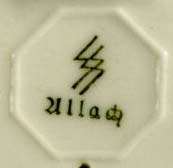Allach (concentration camp)
History

Allach, the largest sub-camp of Dachau concentration camp, opened on March 19th, 1943 because of a workforce shortage in the armament and building industry of Nazi Germany. The camp was also the manufacturing site of Allach porcelain and German Dress uniform Swords and daggers.[1]Allach remained open from March 1943 through its liberation on April 22, 1945, by the US Army.
The porcelain factory Porzellan Manufaktur Allach was established as a private concern in 1935 in the small town of Allach, near Munich, Germany. In 1936 the factory was acquired by the SS. Heinrich Himmler saw the acquisition of a fine porcelain factory as a way to establish an industrial base for the production of works of art that would represent, in Himmler's eyes, true Germanic culture. Allach porcelain was one of Himmler’s favorite projects and produced various figurines (soldiers, animals, etc.) to compete in the small but profitable German porcelain market.
High-ranking artists were locked into contract. The program of the factory included over 240 porcelain and ceramic models. As output at the Allach factory increased, the Nazis moved production to a new facility near the Dachau concentration camp.
The foundry at the Allach camp was run by a school professor from the nearby town. Two of his students were on hand assisting him with the manufacture of the swords and daggers. The produced work typically had the entwined Sig Runes which was an SS proof mark that can also be seen on Allach porcelain.[1]
Camp population
The camp divided Jews from non-Jews as well as men from women.
The number of prisoners varied at different points in time. Approximately 3,000–4,000 men, with many more as Allach became an end point for many death marches and transports from other concentration camps. The women's camp was much smaller at 200–300 persons. Prisoner population in the Non-Jewish camp was mainly French, Russians, Poles, Czechs and Dutch, as well as victims of racial persecution and German opponents of the regime.
Slave labor
It was the first of seven sub-camps to supply the BMW armament factory with slave laborers, where airplane engines were produced and repaired.
Starting from 1941 German civilians and about 50 prisoners of the Allach subcamp of the Dachau concentration camp were employed with production of art and porcelain. the Allach subcamp of Dachau remained the main location for fine porcelain manufacture even after the original factory in the town of Allach was modernized and reopened. The factory in the town of Allach was instead retrofitted for the production of ceramic products such as household pottery. The fall of the Third Reich brought an end to the Allach concern. The Allach factories were shut down in 1945 and never reopened.[2]
Liberation
US soldiers of the 42nd Rainbow Division entered the camp at around 9 o'clock on the morning of April 30, 1945, one day after the main camp at Dachau was liberated. The 66th Field Hospital, attached to the 42nd Division of the US Seventh Army, was brought to Allach to take care of the sick prisoners. By May 10th, they had moved on to help with the typhus epidemic in the main camp.
See also
References
- The United States Holocaust Memorial Museum Encyclopedia of Camps and Ghettos, 1933-1945 (Center for Advanced Holocaust Studies, United States Holocaust Memorial Museum)
- March of Life
- 1 2 Johnson,Thomas M.,Collecting Edged Weapons of the Third Reich, Volume 1-4, 1993
- ↑ Allach Porcelain
External links
- subcamp München-Schwabing United States Holocaust Memorial Museum
- Nazi Crimes on Trial, The Dachau Trials
Coordinates: 48°12′55″N 11°29′30″E / 48.21528°N 11.49167°E